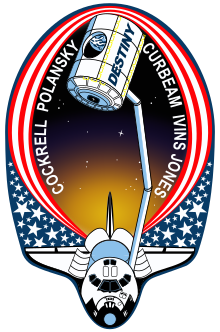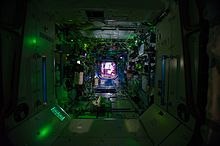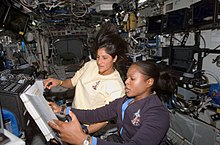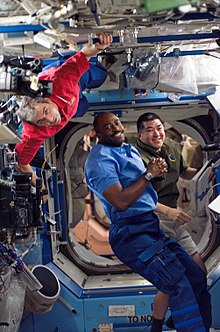
Columbus is a science laboratory that is part of the International Space Station (ISS) and is the largest single contribution to the ISS made by the European Space Agency (ESA).

The Japanese Experiment Module (JEM), nicknamed Kibō, is a Japanese science module for the International Space Station (ISS) developed by JAXA. It is the largest single ISS module, and is attached to the Harmony module. The first two pieces of the module were launched on Space Shuttle missions STS-123 and STS-124. The third and final components were launched on STS-127.
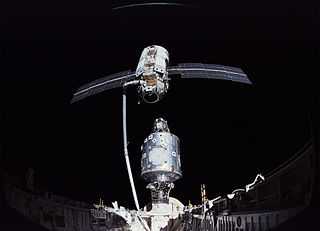
STS-88 was the first Space Shuttle mission to the International Space Station (ISS). It was flown by Space Shuttle Endeavour, and took the first American module, the Unity node, to the station.

STS-98 was a 2001 Space Shuttle mission to the International Space Station (ISS) flown by Space Shuttle Atlantis. It was the first human spaceflight launch of the 21st century. STS-98 delivered to the station the Destiny Laboratory Module. All mission objectives were completed and the shuttle reentered and landed safely at Edwards Air Force Base on 20 February 2001, after twelve days in space, six of which were spent docked to the ISS.

Mario Runco Jr. is a former United States Naval officer and NASA astronaut. He was selected as an astronaut with in 1987. He flew three Space Shuttle missions, performed a spacewalk on his second mission, and is now retired both from NASA and the U.S. Navy.

A Multi-Purpose Logistics Module (MPLM) is a large pressurized container that was used on Space Shuttle missions to transfer cargo to and from the International Space Station (ISS). Two MPLMs made a dozen trips in the Shuttle cargo bay and initially berthed to the Unity module and later the Harmony module on the ISS. From there, supplies were offloaded, and finished experiments and waste were reloaded. The MPLM was then reberthed in the Shuttle for return to Earth. Three modules were built by the Italian Space Agency (ASI): Leonardo, Raffaello, and Donatello.

The Unity connecting module, also known as Node 1, is the first U.S.-built component of the International Space Station (ISS). It connects the Russian and United States segments of the station, and is where crew eat meals together.

Expedition 2 was the second long-duration spaceflight aboard the International Space Station, immediately following Expedition 1. Its three-person crew stayed aboard the station from March to August 2001. In addition to station maintenance, the crew assisted in several station assembly missions, welcomed the first space tourist Dennis Tito, and conducted some scientific experiments.

Harmony, also known as Node 2, is the "utility hub" of the International Space Station. It connects the laboratory modules of the United States, Europe and Japan, as well as providing electrical power and electronic data. Sleeping cabins for four of the crew are housed here.

Tranquility, also known as Node 3, is a module of the International Space Station (ISS). It contains environmental control systems, life support systems, a toilet, exercise equipment, and an observation cupola.

The Minus Eighty-Degree Laboratory Freezer for ISS (MELFI) is a European-built experiment storage freezer for the International Space Station. It comprises four independent dewars which can be set to operate at different temperatures. Currently temperatures of −80 °C, −26 °C, and +4 °C are used during on-orbit ISS operations. Both reagents and samples will be stored in the freezer. As well as storage the freezer is designed to be used to transport samples to and from the ISS in a temperature controlled environment. The total capacity of the unit is 300 litres.
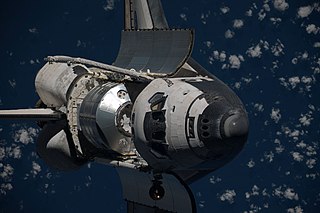
STS-128 was a NASA Space Shuttle mission to the International Space Station (ISS) that launched on August 28, 2009. Space ShuttleDiscovery carried the Multi-Purpose Logistics Module Leonardo as its primary payload. Leonardo contained a collection of experiments for studying the physics and chemistry of microgravity. Three spacewalks were carried out during the mission, which removed and replaced a materials processing experiment outside ESA's Columbus module, and returned an empty ammonia tank assembly.

STS-130 was a NASA Space Shuttle mission to the International Space Station (ISS). Space ShuttleEndeavour's primary payloads were the Tranquility module and the Cupola, a robotic control station with six windows around its sides and another in the center, providing a 360-degree view around the station. Endeavour launched at 04:14 EST on February 8, 2010 and landed at 22:22 EST on February 21, 2010, on runway 15 at the Kennedy Space Center's Shuttle Landing Facility.

STS-131 was a NASA Space Shuttle mission to the International Space Station (ISS). Space ShuttleDiscovery launched on April 5, 2010, at 6:21 am from LC-39A, and landed at 9:08 am on April 20, 2010, on runway 33 at the Kennedy Space Center's Shuttle Landing Facility. The mission marked the longest flight for Space Shuttle Discovery.

The Common Berthing Mechanism (CBM) connects habitable elements in the US Orbital Segment (USOS) of the International Space Station (ISS). The CBM has two distinct sides that, once mated, form a cylindrical vestibule between modules. The vestibule is about 16 inches (0.4 m) long and 6 feet (1.8 m) across. At least one end of the vestibule is often limited in diameter by a smaller bulkhead penetration.

A Pressurized Mating Adapter (PMA) is a spacecraft adapter used on the International Space Station (ISS) to convert a Common Berthing Mechanism (CBM) interface to an APAS-95 docking port. Three PMAs are connected to the US Orbital Segment of ISS. PMA-1 and PMA-2 were launched with the Unity module in 1998 aboard STS-88; PMA-3 was launched in 2000 aboard STS-92. PMA-1 permanently connects the Unity and Zarya modules. IDA adapters have been installed on PMA-2 and PMA-3 which convert them to IDSS docking ports.

Kounotori 2, also known as HTV-2, was launched in January 2011 and was the second flight of the Japanese H-II Transfer Vehicle to resupply the International Space Station (ISS). It was launched by the H-IIB Launch Vehicle No. 2 manufactured by Mitsubishi Heavy Industries (MHI) and JAXA. After the supplies were unloaded, Kounotori 2 was loaded with waste material from ISS, including used experiment equipment and used clothes. Kounotori 2 was then unberthed and separated from the ISS and burned up upon reentering the atmosphere on 30 March 2011.

The Leonardo Permanent Multipurpose Module (PMM) is a module of the International Space Station. It was flown into space aboard the Space Shuttle Discovery on STS-133 on 24 February 2011 and installed on 1 March. Leonardo is primarily used for storage of spares, supplies and waste on the ISS, which was until then stored in many different places within the space station. It is also the personal hygiene area for the astronauts who live in the US Orbital Segment. The Leonardo PMM was a Multi-Purpose Logistics Module (MPLM) before 2011, then was modified into its current configuration. It was formerly one of two MPLM used for bringing cargo to and from the ISS with the Space Shuttle. The module was named for Italian polymath Leonardo da Vinci.

The US Orbital Segment (USOS) is the name given to the components of the International Space Station (ISS) constructed and operated by the United States National Aeronautics and Space Administration (NASA), European Space Agency (ESA), Canadian Space Agency (CSA) and Japan Aerospace Exploration Agency (JAXA). The segment consists of eleven pressurized components and various external elements, almost all of which were delivered by the Space Shuttle.

The Window Observational Research Facility (WORF) is an experiment rack facility manufactured by the Brazilian Space Agency, which remotely operated payloads and crew members can perform Earth and space science research, including hand held photography, at the U.S. Laboratory Science Window on the International Space Station. WORF is based on an International Standard Payload Rack (ISPR) and utilizes avionics and hardware adapted from the EXPRESS Rack program. The rack provides a payload volume equivalent to 0.8 m3 (28 cu ft), and will be able to support up to three payloads simultaneously, depending on available resources and space available at the window. The WORF will also provide access and equipment for crew Earth observations, such as crew restraints, camera/camcorder brackets, and condensation prevention. WORF payloads include those focusing on geology, agriculture, ranching, environmental and coastal changes, and education.

